Affiliate links on Android Authority may earn us a commission. Learn more.
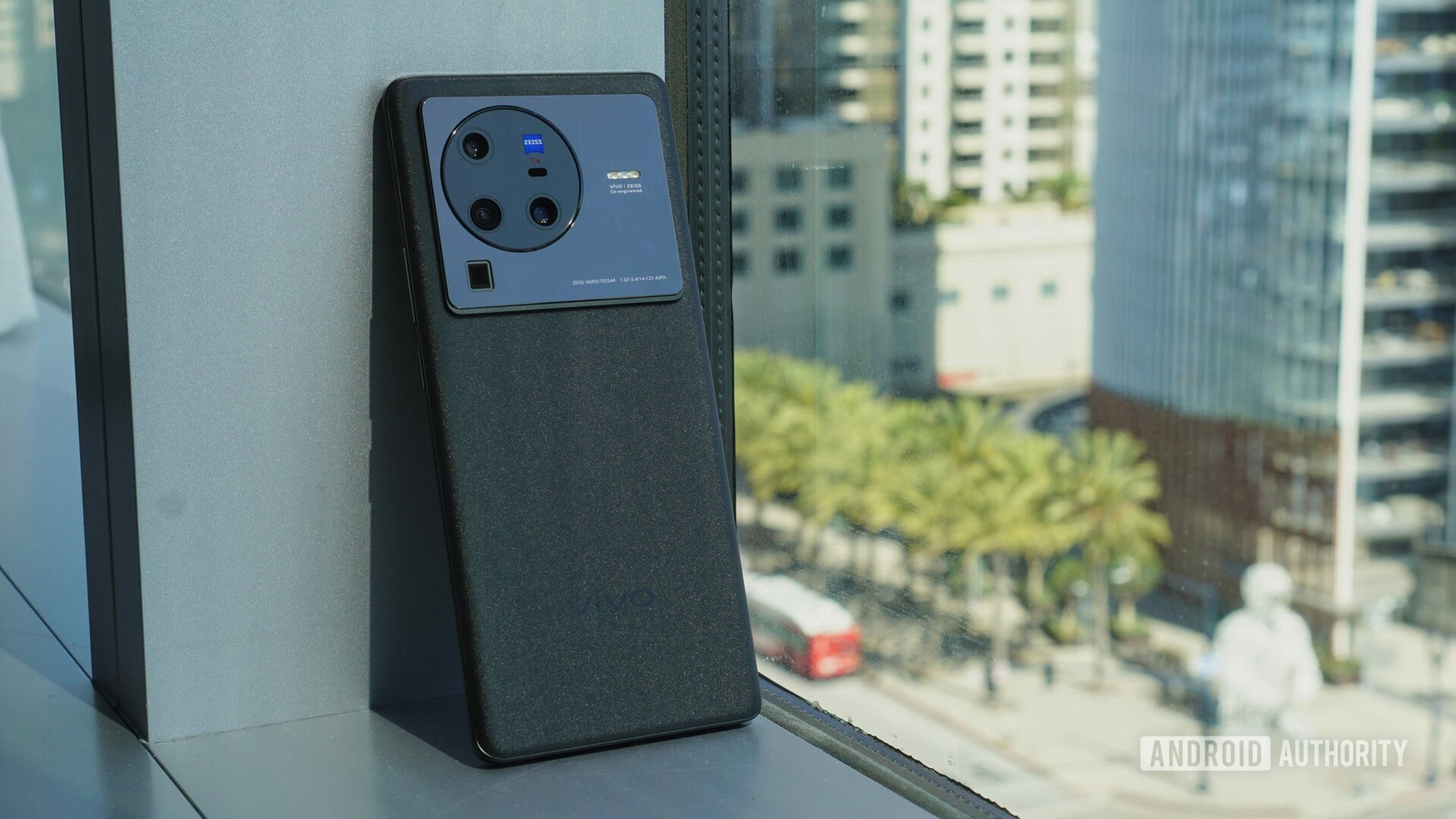

vivo X80 Pro review: vivo's best, (mostly) refined
Published onMarch 17, 2023

Vivo X80 Pro
MSRP:
What we like
What we don't like
Our scores

Vivo X80 Pro
vivo has been steadily upping its game in the high-end segment over the last few years, bringing diamonds in the rough like the vivo X50 Pro and X60 Pro Plus. It finally delivered a genuinely excellent flagship experience in late 2021 with the vivo X70 Pro Plus. The company is back with a flagship phone in 2022 in the form of the X80 Pro. But does this phone live up to vivo’s recent high standards or is it a step back? It’s time to find out in our vivo X80 Pro review.
Update, March 2023: This review has been updated with an alert announcing the Vivo X90 Pro.
What you need to know about the vivo X80 Pro
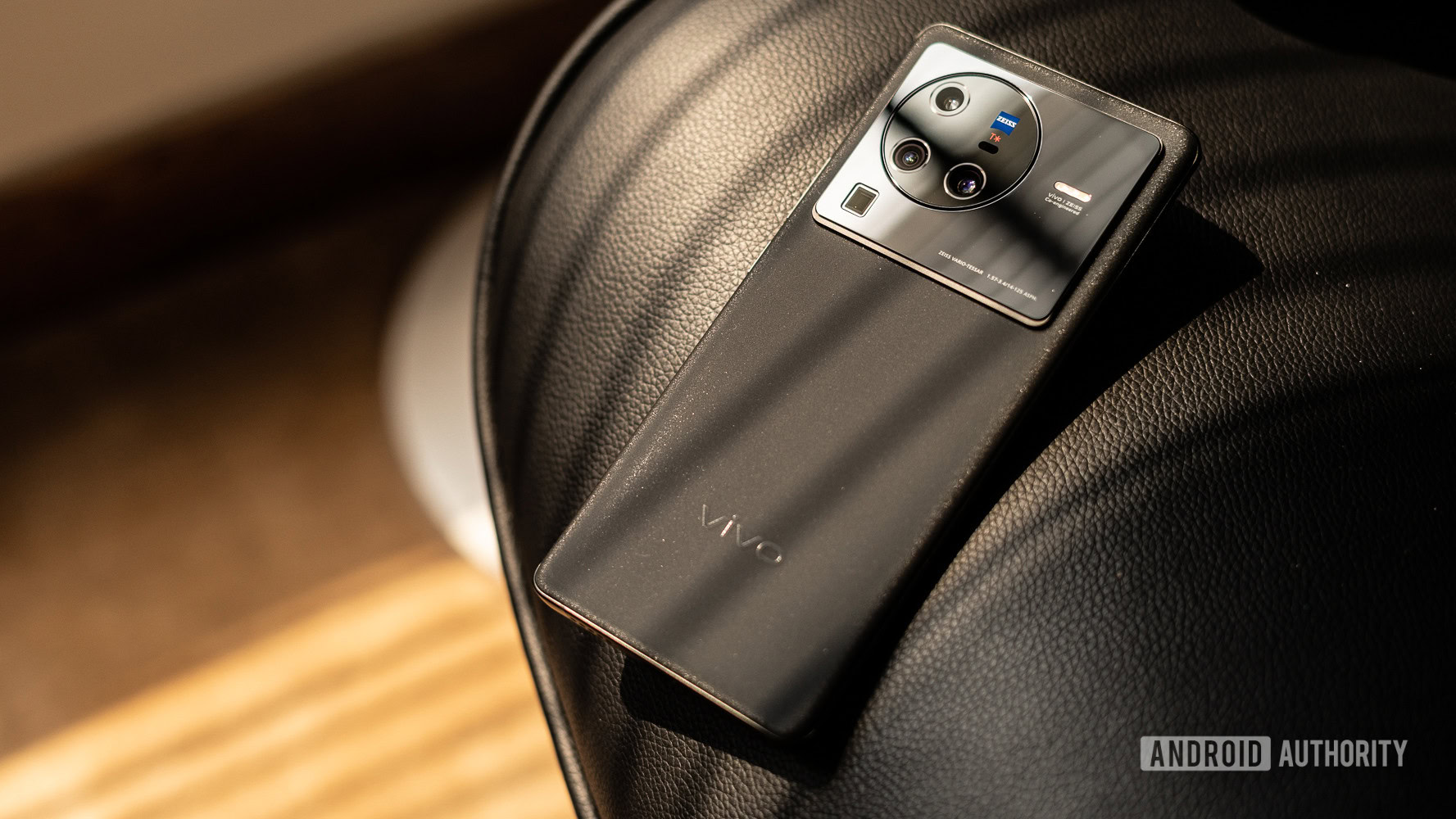
- vivo X80 Pro (12GB/256GB): £1,199 / €1,299 / Rs. 86,999 (~$1,121)
There’s no vivo X80 Pro Plus, which means the X80 Pro is the top dog in vivo’s portfolio for 2022. The Pro variant has everything you’d expect from a modern premium flagship, namely the Snapdragon 8 Gen 1 chipset, fast wired and wireless charging, a QHD+ 120Hz OLED screen, and IP68 water/dust resistance.
The company’s strength has been its cameras in the last couple of years. This looks like it could be the X80 Pro’s strength too, owing to a similarly flexible rear camera system, several ZEISS enhancements (such as portrait mode styles, video bokeh, and a lens coating to reduce lens flare), and the vivo V1 Plus imaging chip.
Related: The best Android phones
One major change this time, however, is that vivo’s micro-gimbal stabilization system has moved from the ultrawide camera to the 2x telephoto lens. So we do have reservations about ultrawide performance this time around but, hopefully, the 2x camera delivers the goods.
vivo says the X80 Pro will be available in Europe (including the UK), the Middle East, India, and South East Asia. The phone is only available in Cosmic Black, which is a shame once again when China gets an orange faux leather option and a turquoise AG Glass variant.
The X80 Pro was also accompanied by the standard X80 for the global launch. This device features a similarly powerful Dimensity 9000 processor, but misses out on a QHD+ display resolution, high-resolution ultrawide camera, 5x periscope lens, micro-gimbal stabilization, and wireless charging.
Is it well designed?
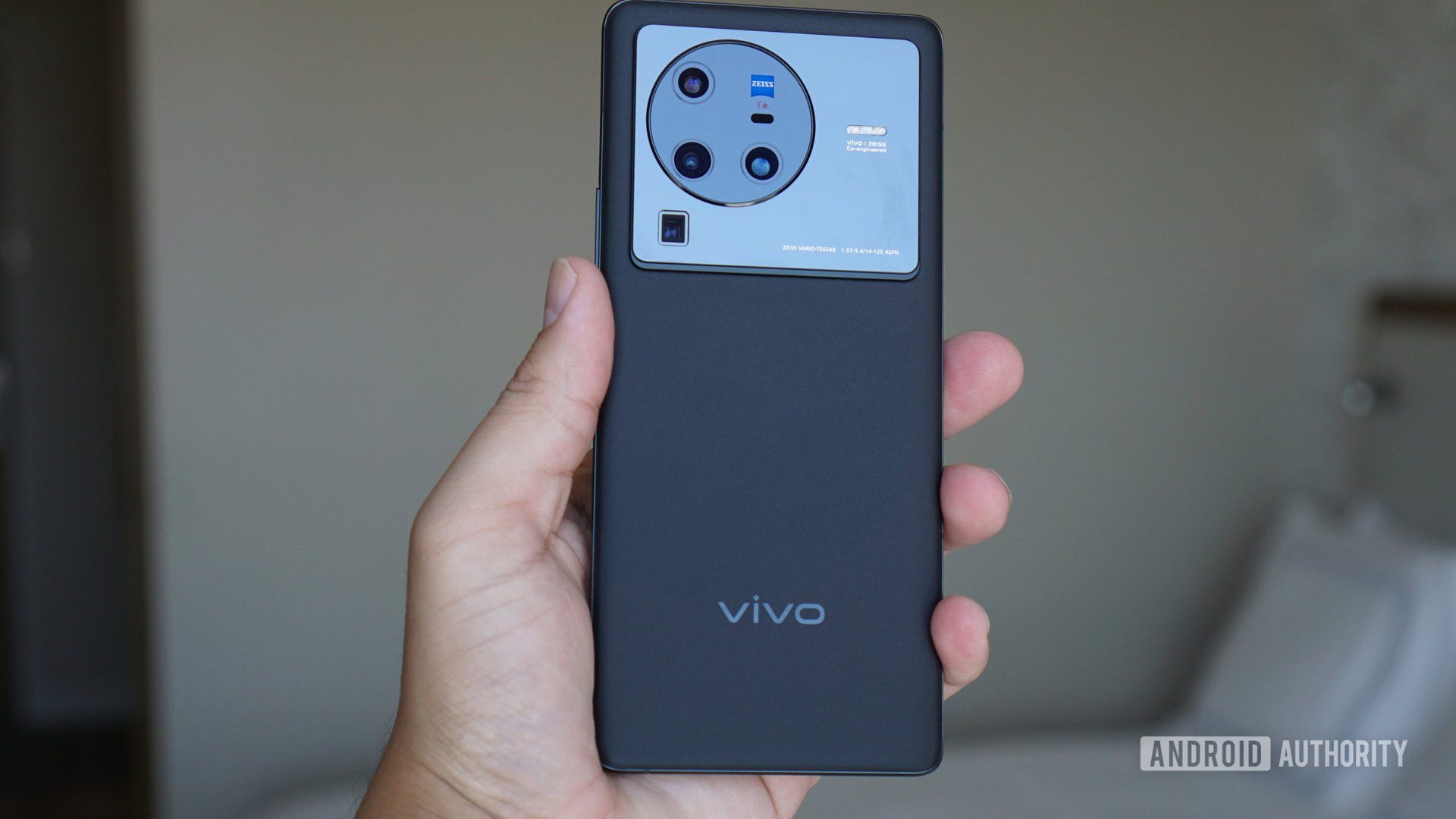
It’s hard to tell the X80 Pro and X70 Pro Plus apart when looking at them from the front. Both devices sport a curved 6.78-inch QHD+ OLED panel (120Hz LTPO E5), for one.
Look at the back and you’ll also find similarities here, with both global variants being a black model with a so-called AG Fluorite Glass back. The black variant’s material is definitely a unique take on glass, offering a matte-like feel and a glinting, sandpaper-like visual effect. However, the biggest difference between the two is that the X80 Pro features a revised camera bump.
The X70 Pro Plus featured a camera housing design that felt unnecessarily large, with the so-called ceramic cloud window on the right being a cosmetic decision, while all the sensors were housed in a separate, rectangular camera bump on the left side of the phone.
Meanwhile, the X80 Pro still has a huge camera housing, complete with a circular element housing most cameras. But you’ll also find the flash and periscope camera outside this circular element. So while the camera housing is similarly large here, it definitely feels like a smarter use of the space.
The X80 Pro has a more sensibly designed rear camera system, but it's still a large phone.
We thought the X70 Pro Plus was a little too big for our liking and the same holds true for the new phone. Those hoping for a smaller flagship phone will need to check out devices like the Xiaomi 12, iPhone 13, and Galaxy S22/S22 Plus.
You’ve also got an IR blaster at the top, while a pair of dual stereo speakers offer suitably loud audio (albeit with the bottom-firing speaker pumping out slightly more volume). You shouldn’t have any problems if you’re listening to podcasts or watching YouTube videos via the speakers.
How good are the vivo X80 Pro’s cameras?

vivo made major strides with the camera experience on its last few flagships, and the X80 Pro is no different. The new phone sports a 50MP Isocell GNV main camera (f/1.57, 1/1.3-inch sensor size, OIS), 48MP IMX598 ultrawide camera (114-degree FoV, OIS), a 12MP 2x telephoto lens with micro-gimbal stabilization, and an 8MP 5x periscope shooter.
This is very similar to the X70 Pro Plus bar the upgraded V1 Plus imaging chip and the micro-gimbal system switching from the ultrawide camera to the telephoto shooter. So what do these changes actually mean, then?
Well, daytime images taken with the primary camera are very pleasantly saturated, as has become a tradition for vivo now (although there is a ZEISS True Color toggle in the viewfinder for more realistic, muted hues). There’s more than enough detail for cropping too, while dynamic range continues to be another strength for the brand. Noise is restricted to darker areas of a scene when it does pop up, but it’s kept to a minimum most of the time. I did notice that the phone captures less resolvable detail and more noise than the X70 Pro Plus on the very odd occasion, but this didn’t happen often enough to be an issue.
Related: The best camera phones you can get
Vivo’s become one of the leading players when it comes to night photography, and this trend continues here too. We do obviously see an overall drop in detail with the primary camera, with low-light images being a little softer than daytime snaps and photos sometimes being over-sharpened just a tad. But you’re still getting some clear, bright shots that can go toe-to-toe with the best flagship cameras out there. Thankfully, the phone doesn’t usually turn the brightness up to daytime levels.
Moving to the ultrawide, vivo’s 48MP shooter definitely offers a healthy amount of detail and a low level of noise for an ultrawide shooter. In saying so, the camera sees inconsistent color reproduction compared to the main shooter, boosting the contrast and sometimes crushing black hues. Distortion correction is also a missing feature that’s overdue. It must be said 114 degrees isn’t as wide as some other players and therefore shouldn’t be as prone to distortion, but it’s a very noticeable problem when objects and subjects are near the edge of the scene.
The X80 Pro's ultrawide camera is still great in most conditions, but color reproduction and distortion are two areas that could be improved.
Despite the lack of micro-gimbal stabilization, the ultrawide camera doesn’t fare too badly when the light goes down either. You’ll see a similar level of brightness to the main shooter in cityscapes and similarly lit scenes, although you’ll certainly notice fine detail such as text and signs are significantly reduced, and noise takes a noticeable hike compared to the main camera (particularly in the sky).
However, absolute darkness sees the primary camera handily pull ahead, delivering a brighter shot compared to a pitch-black snap seen with the ultrawide. Check out the comparison below showing a dark but not pitch-black scene — you’ve got similarly bright shots here but elements like the number plate and walls are stripped of detail in the ultrawide sample.
The ultrawide camera also pulls double duty for macro photography, with vivo allowing you to either force a super macro mode (cropping in to ~1x from the ultrawide), set it to be automatic, or turn it off completely. Shots using the super macro mode sometimes look decent but are often horribly over-sharpened. You’re better off disabling the mode and manually switching to the ultrawide camera or cropping in from the main shooter.
We didn’t have high hopes for class-leading long-range zoom on the X80 Pro as it’s equipped with a similar 2x and 5x zoom camera setup to the X70 Pro Plus. The 12MP 2x optical camera does a pretty great job at its zoom factor, offering an image that isn’t 100% consistent with the main camera but gets closer than the other sensors. The 5x periscope camera, on the other hand, aggressively dials up the sharpness levels at times. Images are otherwise fine at 5x itself, but going past 5x results in disappointing shots that are devoid of detail and pale in comparison to the likes of the Pixel 6 Pro and Galaxy S22 Ultra.
The 2x telephoto camera is equipped with a micro-gimbal stabilization setup, so you’d think vivo would lean on it for low-light 2x shots given the added stability. However, it seems like the phone switches between a native 2x photo and a cropped-in shot from the primary camera just as often as the X70 Pro Plus. In fact, some scenes saw the X80 Pro use the 2x camera and the older phone use a 1x crop, while the situation was reversed for other scenes. When it’s actually used, however, the 2x camera can definitely grab a bright shot with a respectable level of fine detail compared to the primary camera.
vivo also hyped a so-called Sports Pan feature (using the 2x camera and accessible via portrait mode) on the X80 Pro, and it seems like a take on Google’s Action Pan option at first glance. That is, it blurs the background but keeps the fast-moving subject in focus. Unfortunately, vivo’s mode only works on scenes featuring people, which means cars and other fast-moving subjects are out of the question. As for the execution, Sports Pan shots vary between pretty cool with minor depth estimation errors to terribly unpolished. Check out one of the better examples we captured below.

You’d think that 2x video recording would be stable due to the presence of a micro-gimbal stabilization system. However, one weird issue we noticed out of the box was that the phone wasn’t actually filming 2x video with the 2x camera, simply cropping in from the main camera instead. We asked vivo about this but the company didn’t get back to us as of writing.
Fortunately, it seems like a recent system update has introduced the ability to natively record via the 2x camera, albeit with either no stabilization or using the standard stabilization option. Native 2x recording in the latter mode tops out at 1080p/30fps though, with 1080p/60fps and higher switching to a cropped 2x via the primary camera.
We’re glad to see the phone offering stable, vivid video in general though. The stabilization and associated quality options are still the same here. That means standard stabilization tops out at 4K/60fps, ultra stabilization still tops out at 1080p/60fps, and the impressively stable horizon line stabilization mode only hits 1080p/30fps. We would’ve liked to see a few improvements here over the previous phone, such as higher resolution/frame-rate support at the various stabilization options, but you should still expect good results. Check out a sample clip of ultra stabilization below and another video sample over here.
Vivo’s phones also continue to be great options for portrait mode owing to the variety of ZEISS and in-house portrait styles on offer. One other new addition this time is the cinematic style bokeh portrait style, shooting at 2.39:1 and offering a lens flare bokeh effect. This does veer into gimmicky territory at times but it’s there for those who care about portrait options and/or die-hard JJ Abrams fans. You can view a sample below.

Selfie quality is in line with 2021’s phone as well, offering a 32MP punch-hole camera and usually delivering detailed shots in ideal conditions. Image quality does see a drop indoors, in low light, and in some backlit situations though, owing to an increase in grain as well as a washed-out image in backlit scenes. Selfie images in general do look soft now and again too — best to take two or three shots.
The X80 Pro packs a few more notable camera options as well, such as a cinematic bokeh video mode, log video support, the impressive Horizon Line Stabilization mode seen on the X70 Pro Plus (albeit still at 1080p/30fps), and a ZEISS Natural Color toggle for more realistic hues. Other modes include a supermoon mode, a neat teleprompter option (allowing you to read lines of your choosing while recording), astrophotography mode, pro sports option to freeze fast-moving subjects, a pro mode, and AI group portrait mode (offering better facial detail for group portraits).
You can view full-resolution photo samples via our Google Drive link over here.
What about performance and battery life?
The global vivo X80 Pro is only available with the Snapdragon 8 Gen 1 chipset, unlike the Chinese variant that comes with a Dimensity 9000 option too. Nevertheless, the combo of this modern chipset and 12GB of LPDDR5 RAM means you’ve got a powerful experience on paper.
This is borne out in benchmarks too, as Geekbench, 3DMark Wildlife, and GFXBench’s T-Rex off-screen test all offer results in line with or better than other Snapdragon 8 Gen 1 phones. For what it’s worth, we tried a spoofed version of Geekbench disguised as Genshin Impact, and we only saw a small drop in multi-core score. What about the real-world experience, though?
Fortunately, the X80 Pro has generally been a brisk performer in practice. Multitasking, app launches, web browsing, and using the camera have all been smooth experiences. I did notice that the in-display fingerprint scanner would be slow to display when picking the phone up (along with a juddery animation), but a system update has seemingly resolved this behavior.
Gaming has been pretty great on here too, as demanding titles like Call of Duty: Mobile, Grid Autosport, and Genshin Impact have all run at a smooth pace for the most part. However, we do see the odd stutter now and again in Genshin, especially when swiping around in busy areas. Apex Legends also ran at a good pace here with graphics settings turned up.
Horsepower shouldn't be a concern for the vivo X80 Pro when it comes to system and gaming performance.
One downside here is that the X80 Pro is equipped with a fixed 256GB of storage. This is a solid level of storage for many users, but we could see keen videographers and mobile gamers running out of space after a while. We would’ve liked a 512GB model as seen in China given the lack of microSD expansion.
vivo has also seen fit to upgrade the battery and wired charging specs here, serving up a 4,700mAh battery and 80W wired charging compared to the X70 Pro Plus’ 4,500mAh battery and 55W wired charging. Otherwise, you’ve still got 50W wireless charging in tow here.
I found that the X80 Pro was usually able to deliver roughly seven hours of screen-on time and about a day and a half of regular usage. This usage consisted of browsing Reddit, taking dozens of snaps, over an hour of YouTube playback, 20 to 30 minutes of gaming, and some music streaming. This was achieved using FHD+ resolution and the smart switch refresh rate setting. It’s not bad at all, so you should be confident that the phone can handle a day of heavy usage.
Once you’ve drained the battery, you’ll be happy to know that proprietary 80W wired charging takes the phone from zero to 100% capacity in 37 minutes (taking 20 minutes to reach 74%). That’s just two minutes shy of vivo’s 35-minute claim. So those who value sub-one-hour charging times will be happy here.
vivo also offers 50W wireless charging much like its predecessor, touting a 100% charge in just 50 minutes. We didn’t get a chance to put this to the test, though. There’s also no guarantee that the required proprietary charger will actually be available in your region, but at least it works with standard Qi wireless charging pads, albeit at much slower speeds.
How good is the screen?
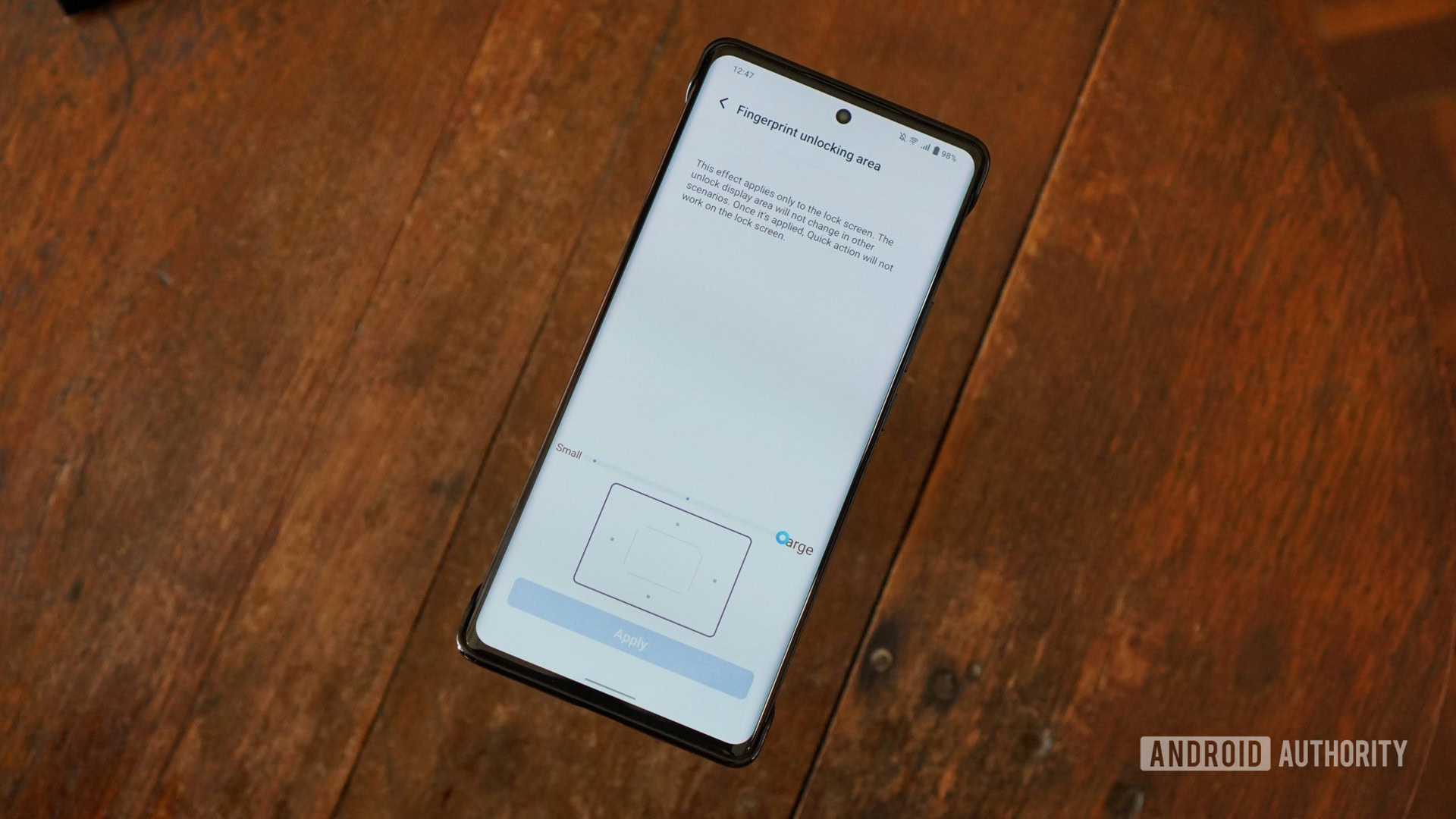
We loved the panel on the X70 Pro Plus, and the screen offers a great experience here too, featuring LTPO 2.0 tech and a 120Hz refresh rate. vivo says the panel is capable of dropping down to as low as 1Hz, but I’ve only noticed it dropping to 10Hz when using the Kindle app and pre-installed gallery app.
You’ve also got decent scope for customization here, including three color modes (standard, professional, and bright), color temperature adjustments, and a visual enhancement toggle for more vivid colors and contrast. There’s also the aforementioned screen resolution (FHD+ or QHD+) and refresh rate options (60Hz, 120Hz, smart switch). I generally found the panel to offer slightly saturated colors out-of-the-box, but it got bright enough for outdoor viewing and I never had trouble with the auto-brightness either.
However, our favorite thing about the display isn’t actually the screen itself but rather the in-display 3D ultrasonic scanner which offers a much wider scanning area than solutions found on any other commercial phone to date, while also allowing for one-touch fingerprint enrolment. This is easily the best in-display fingerprint sensor I’ve ever used on a smartphone and I hope it becomes the norm soon.
Interestingly, vivo also takes advantage of the wider scanning area for a cool app shortcut feature. You can add a desired app to the fingerprint unlock area, allowing you to unlock the phone and seamlessly enter the desired app in one go. The phone even lets you access hidden apps by scanning two of your fingers at once.
Anything else?
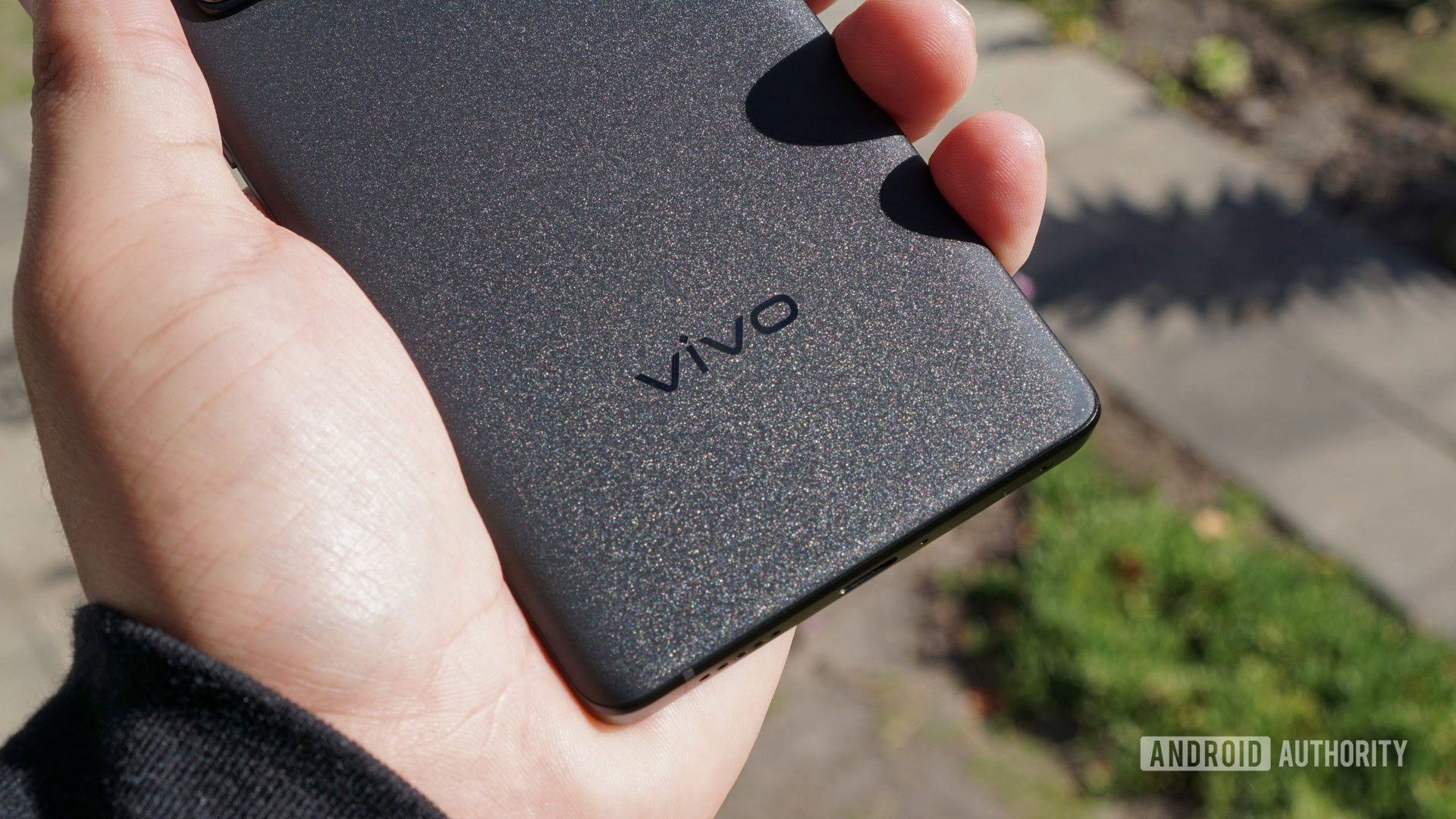
- Bloatware: Funtouch OS was rightfully overhauled to become a more stock-like experience a year or two ago, but vivo still needs to address the unhealthy amount of bloatware here. Everything from Facebook and Agoda to Shopee and vivo’s own Hot Games and Hot Apps shortcuts is found in the app drawer by default. Some of this bloatware can be removed, but others like vivo’s Hot Apps/Games and Facebook’s underlying system apps can’t be uninstalled. A real shame.
- Software update pledge: The X80 Pro will get three major OS updates and three years of security patches. We can understand vivo boasting about the former but the latter isn’t anything special when Samsung and Google are offering up to five years of security patches. It’s not the worst update guarantee, but we’ve seen all of vivo’s BBK stablemates do better, and it’s fair to expect more from a phone at this price.
- No mmWave 5G: The US and Japan are among the few markets offering mmWave 5G right now, but it’s still worth noting that the X80 Pro lacks support for this speedy 5G option.
- Connectivity: vivo’s phone packs comprehensive Bluetooth support, an IR blaster, and more. However, two options you shouldn’t expect on the phone are Wi-Fi 6E and UWB. It’s not a massive deal given that neither standard is mega-popular right now, but they’re still noteworthy omissions on a premium flagship when other phones at the same price point are including them.
vivo X80 Pro specs
| vivo X80 Pro | |
|---|---|
Display | 6.78-inch QHD+ 1,440 x 3,200 AMOLED, HDR10+ 120Hz refresh rate 240Hz touch response In-display fingerprint sensor |
Processor | Qualcomm Snapdragon 8 Gen 1 Adreno 730 GPU |
RAM | 12GB |
Storage | 256GB Non-expandable |
Battery | 4,700mAh 80W wired charging 50W wireless charging |
Cameras | Rear: 50MP standard at f/1.57, OIS 48MP ultrawide at f/2.2, OIS 12MP 2x telephoto for portraits at f/1.85, micro-gimbal 8MP 5x periscope sensor at f/3.4, OIS Video: 8K at 30fps, 4K at 30/60fps, 1080p at 30/60/120/240fps, 720p at 480fps Front: 32MP |
IP rating | IP68 |
Headphone jack | N/A |
Connectivity | IR blaster NFC Wi-Fi 6 Bluetooth 5.2 Supports SBC, AAC, aptX, aptX HD, aptX Adaptive, LDAC codecs |
Software | Funtouch OS 12 Android 12 |
Dimensions and weight | 164.57 x 75.3 x 9.10mm 219 grams |
Value and competition

A phone like the vivo X80 Pro absolutely needs to be a premium flagship experience if it has a recommended price of £1,199 in the UK, €1,299 throughout the rest of Europe, and a current price of Rs. 86,999 in India. This puts it well into the same league as premium phones from Samsung, Google, Apple, OPPO, and Xiaomi.
Fortunately, the vivo indeed brings a premium proposition to the table, serving up powerful silicon, a long-lasting yet fast-charging battery, a flexible and high-quality camera experience, and a variety of premium extras (IP68 rating, fast wireless charging, QHD+ resolution).
The most prominent competitors are the Samsung Galaxy S23 Plus ($999.99 at Samsung) and Galaxy S23 Ultra ($1199.99 at Samsung). Samsung’s Plus phone stands out thanks to a more ergonomic size and a much better update commitment. The Ultra variant ups the ante even more thanks to an S Pen and integrated slot, a bigger battery, and the best zoom cameras in the business (offering 3x and 10x zoom). You do sacrifice wired and wireless charging speeds as well as that giant fingerprint scanner if you opt for these phones, however.
More suggestions: The best phone deals
The OnePlus 11 ($1296 at Amazon) is another alternative worth considering, especially if you value performance and battery life. This device also serves up a Snapdragon 8 Gen 2 chipset, high-quality screen, and a big battery with fast wired charging. Unfortunately, you’ll miss out on wireless charging, water resistance, and great low-light imagery.
The OPPO Find X5 Pro ($999 at Amazon) is worth a look if you value some of the X80 Pro’s strengths like a great ultrawide camera, QHD+ 120Hz screen, and fast charging all around. OPPO’s phone also packs an eye-catching design and a bigger battery, but you do sacrifice that fantastic fingerprint scanner and decent zoom capabilities. Like the X80 Pro, it’s also super expensive in Europe, though UK buyers get a much better deal.
We’d also recommend the Pixel 7 Pro ($589.98 at Amazon) if you want a well-rounded premium flagship experience but don’t want to spend a ton of cash. The latest Google phone doesn’t have vivo’s variety of video options or fast charging, but does serve up fantastic images, a more competitive zoom camera, Pixel-exclusive software features, and five years of security patches.
Don’t mind an Apple alternative? Then the iPhone 14 Pro ($799.99 at Amazon) is worth considering too. You do lose out on that giant fingerprint scanner, a variety of camera modes, and a more competitive ultrawide camera, but gain long-term update support, a more powerful chipset, and access to Apple’s ecosystem.
vivo X80 Pro review: The verdict
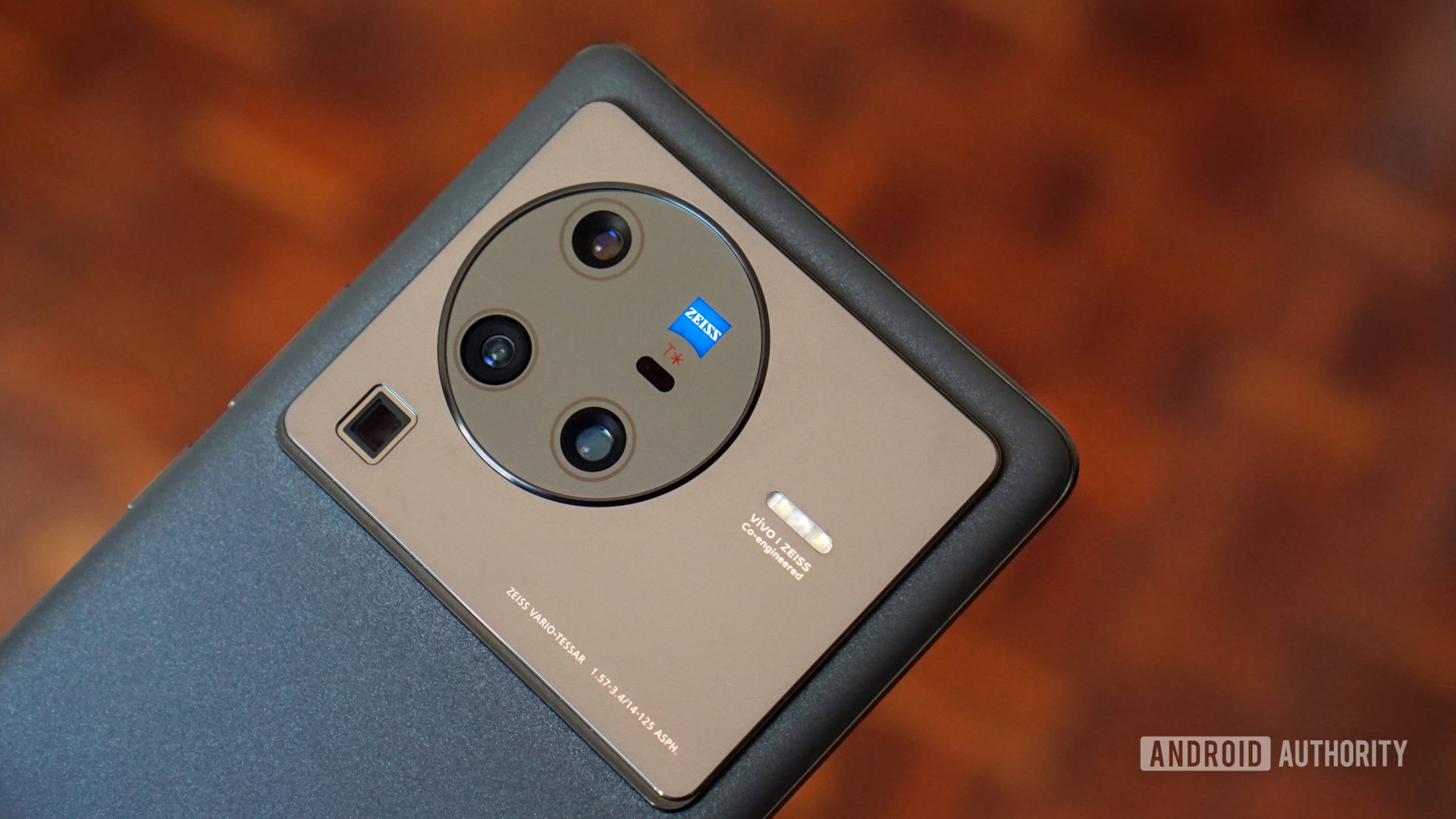
The vivo X80 Pro isn’t a revolution compared to its previous flagship, but it doesn’t need to be when the X70 Pro Plus got so much right in the first place. The 2022 flagship maintains features like a QHD+ 120Hz OLED screen, IP68 rating, and a flexible rear camera system, while bringing even faster wired charging, a small but welcome battery capacity upgrade, and the best in-display fingerprint sensor on a smartphone.
In saying so, some of the X70 Pro Plus’s shortcomings are still keenly felt here. The phone is still on the large side (although fans of big phones will love it), vivo is still packing its phones with boatloads of bloatware, and rival brands like Samsung and Google have left it in the dirt when it comes to long-range zoom. vivo’s insistence on only offering the standard three years of security patches is also disappointing, even though it’s stepping up with three OS updates.
The vivo X80 Pro brings a few quality-of-life improvements to its already slick flagship proposition, but don't expect a huge upgrade.
The company seems to be learning from its availability woes in 2021 at least, as the new phone is far more widely available. Yet while users are certainly getting a high-quality phone to take on Samsung’s Ultra line, the price in the UK and the rest of Europe is mightily high, pitting it against the best from Samsung, Apple, Google, and more.
vivo set out to refine its well-received premium flagship formula and, bar a couple of areas of improvement that continue to stagnate, it’s succeeded in doing so. Whether or not it’s worth the high asking price will depend on how much you value its more unique features against the support and consistency of the very best phones on the market.
vivo X80 Pro top questions and answers
The vivo X80 Pro has an IP68 rating for protection against water and dust.
Yes, the vivo X80 Pro is available to buy in the UK and other regions in Europe via Amazon and other retailers.
vivo has yet to confirm what glass is being used on the display, but we know the back uses AG Fluorite Glass. We’ve asked vivo to clarify.
Yes, vivo continues to bundle a charger in the box. You’ve got an 80W charger here, but it also delivers 65W USB-PD support so you can charge other devices.
No, the vivo X80 Pro does not have a 3.5mm headphone jack.